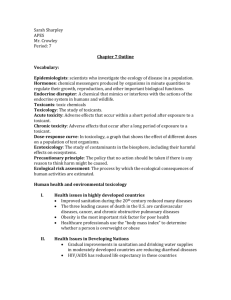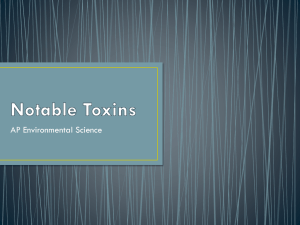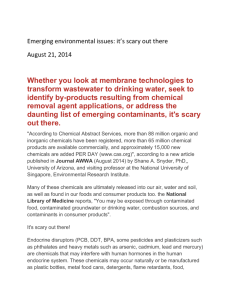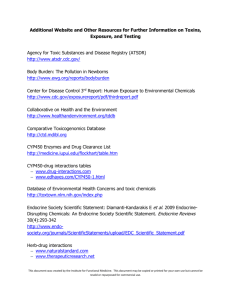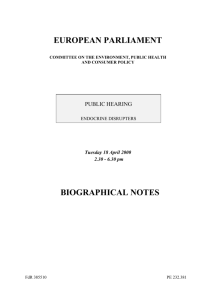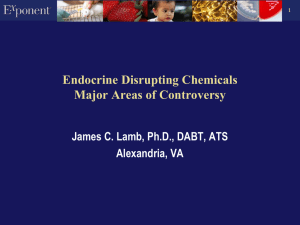Toxicology and Environmental Toxicants
advertisement
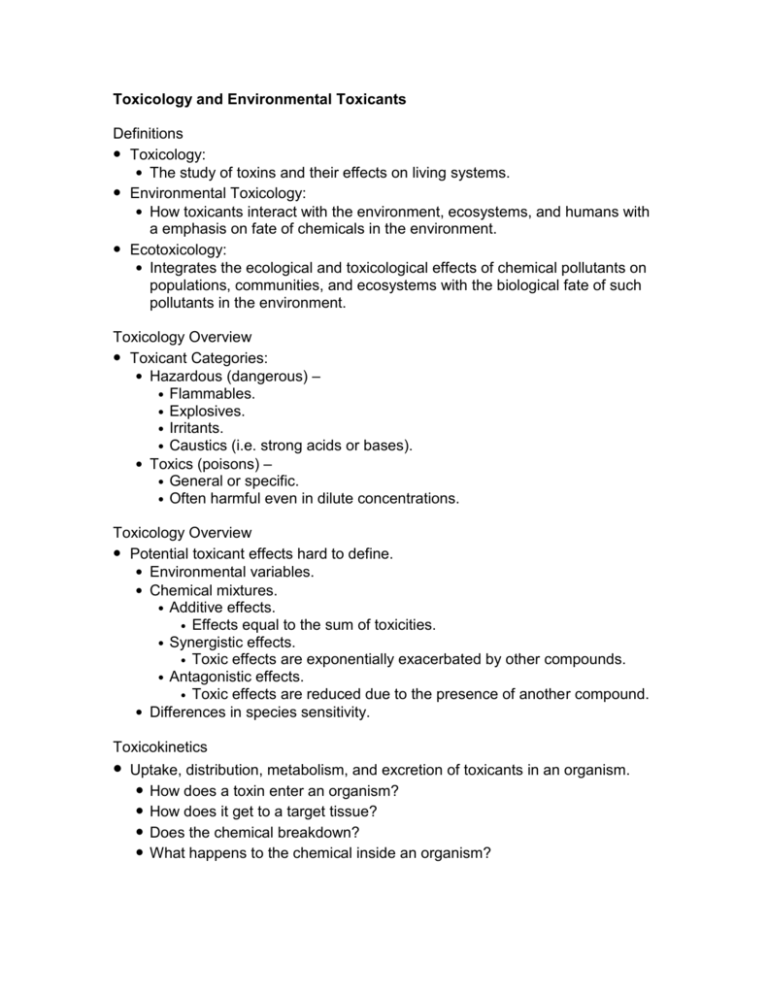
Toxicology and Environmental Toxicants Definitions • Toxicology: • The study of toxins and their effects on living systems. • Environmental Toxicology: • How toxicants interact with the environment, ecosystems, and humans with a emphasis on fate of chemicals in the environment. • Ecotoxicology: • Integrates the ecological and toxicological effects of chemical pollutants on populations, communities, and ecosystems with the biological fate of such pollutants in the environment. Toxicology Overview • Toxicant Categories: • Hazardous (dangerous) – • Flammables. • Explosives. • Irritants. • Caustics (i.e. strong acids or bases). • Toxics (poisons) – • General or specific. • Often harmful even in dilute concentrations. Toxicology Overview • Potential toxicant effects hard to define. • Environmental variables. • Chemical mixtures. • Additive effects. • Effects equal to the sum of toxicities. • Synergistic effects. • Toxic effects are exponentially exacerbated by other compounds. • Antagonistic effects. • Toxic effects are reduced due to the presence of another compound. • Differences in species sensitivity. Toxicokinetics • Uptake, distribution, metabolism, and excretion of toxicants in an organism. • How does a toxin enter an organism? • How does it get to a target tissue? • Does the chemical breakdown? • What happens to the chemical inside an organism? Toxicokinetics Elements of Exposure • • Bioaccumulation: • Chemical is retained in an organism and not excreted. Biomagnification: • Chemicals that are stored in the body are concentrated at higher trophic levels. Trophic Energy Profile Exposure • How are organisms exposed? • Concentrations. • Lethal doses (LD50). • Duration. • Chronic Exposure. • Acute Exposure. • Lipophilic Chemicals: • Fat-loving. • Dissolves in oil. • Hydrophilic Chemicals: • Water-loving. • Dissolves in water. Chemical Toxicity Toxicological Endpoints • • Biological effects of contaminants: • Mutagenic. • Teratogenic. • Carcinogenic. Environmental contaminant fates: • Chemicals vary in the degree of persistence in the environment. • Persistent Organic Pollutants (POPs). • Breakdown products often more harmful. Toxicological Endpoints • How are organisms affected? • Physiological systems affected. • Nervous System / Behavior. • Neuromuscular. • Heavy metals. • Reproductive system / Reproduction. • Organ function: • Kidneys. • Liver. • Immune System. • Endocrine System. Immune System Affecter • Immune system components: • Cellular immunity (T cells, macrophages) • Humeral immunity (B cells, antibodies, allergies). • Immune suppression: • PCBs/dioxins target T cells and organs producing them. • 18,000 European common seals wash up dead in 1988. • All confirmed infected with phocine distemper virus (PDV). • Extremely high PCB concentrations. Endocrine Disruptor • Endocrine system: • Hormones – Chemical messengers. • Endocrine glands. • Controls primary body functions: • Metabolism. • Growth and development. • Reproduction. • Chemical feedback networks. • Very low doses yield pronounced effects. Endocrine Disruptor • Important hormones: • Growth hormone. • Prolactin. • Oxytocin. • Thyroid Hormones. • Insulin. • Cortisol. • Adrenaline. • Testosterone. • Estrogen. Endocrine Disruptor • Chemicals that mimic or replace natural hormones. • Xenobiotics (usually) have weak affinity to natural receptors. • Large concentrations out-compete natural hormones. • Most pronounced effects with sex hormones and thyroid hormones (teratogens). • Also ‘behavioral’ and ‘stress-related’ hormones. Endocrine Disruptor • Observed effects: • Mortality. • Teratogens. • Goiters. • Feminization. • Sex-reversal. • Hermaphroditism. • Imposex. • Impotence. • Sterilization. • Behavioral. • Reproductive. • Parental care. • Stress responses. • Altered pheromones. Endocrine Disruptors POPs • Resistant to environmental degradation. • Lipophilic, bioaccumulates, biomagnifies. • Capable of long-range transport. • Concentrates at geographic poles. • UNEP categorized as the following chemicals: • Aldrin. • Chlordane. • DDT. • Dieldrin. • Endrin. • Heptachlor. • Hexachlorobenzene. • Mirex. • Polychlorinated biphenyls. POPs • Who is affected most? • At what cost? DDT • Dichloro-diphenyl-trichloroethane (DDT) • First synthesized in 1874. • Insecticidal use not realized until 1939. • Paul Hermann Müller – 1948 Nobel Prize in Physiology and Medicine. DDT • • • • • • DDT Heavily used following WWII. Contributed to eradication of malaria in Europe and U.S. Rachel Carson writes Silent Spring (1962). U.S. EPA banned (1972). Breakdown products more harmful and environmentally longer lasting. Responsible for near extinction of many species of raptors (i.e. Bald Eagle, Osprey, Peregrine Falcon) Heavy Metals • Mercury • Industrial pollutant. • Metal refining / production. • Batteries. • Fluorescent bulbs. • Thermometers. • Fossil fuels. • Mining discharge. • Minamata Bay, Japan. • Fertilizer/petrochemical company polluted from 1932-1968. • Sickness, deformities, and death to 3,000 people. Heavy Metals • Mercury • Fish advisories / warnings. • Biomagnifies. • Breakdown product more toxic. • Primarily affects nervous system. • Also damages GI, kidney. • Mutagenic. Heavy Metals • Lead • Uses: • Weights / sinkers. • Batteries. • Glass. • Solder. • Firearm projectiles. • Previous uses: • Paint. • Gasoline. • Plumbing. Heavy Metals • Lead • Primarily affects nervous system. • Linked to Alzheimer disease and schizophrenia. • Also causes blood and kidney disorders. • Chronic doses affect reproduction. • Children most susceptible. • Bioaccumulative. • Birds (especially raptors) at risk. Dioxins / PCBs • Dioxins: • Industrial byproducts. • Paper bleaching / pulp processing. • Herbicide / pesticide / chemical production. • Plastic / wood incineration. • Considered one of the most toxic human-made chemicals known. • Bioaccumulative. • Lipophilic. Dioxins / PCBs • PCBs: • Produced since 1929 for: • Insulators. • Electrical components and capacitors. • Flame retardants. • Paints. • Lubricants. • Hydraulic fluids. • Bioaccumulative. • Extremely stable. • Lipophilic. • Banned by the U.S. EPA in 1977. Dioxins / PCBs • Primarily affects immune system. • Teratogenic. • Impairs reproductive system and behavior. • Wasting syndrome. • Carcinogenic. • Endocrine Disruptor. Emerging Chemicals of Concern • PBDEs • Similar to a Brominated PCB. • Thyroid disruptor. • Potential teratogen. • Extremely stable / persistent. • Found in human breast milk worldwide. • PFOS / PFOA • Fluorinated compounds. • Used to make ScotchGuard (3M), Teflon (DuPont) and Gor-Tex. • Extremely stable / persistent. • PFOS ~8 year half-life in humans. • Believed teratogenic and carcinogenic. • Scotchguard reformulated in 2000. Environmental Fate • Historic POP levels dropping. • Leveled-out. • Wildlife is recovering. • Replaced by new POPs. What’s next? • • • 100,000 chemicals are used today. Pesticides/herbicides still widely used. Modern insecticides short-lived. • More acute effects.
